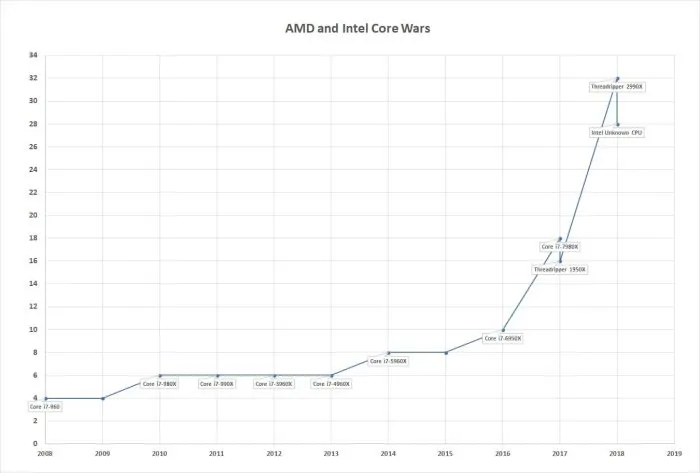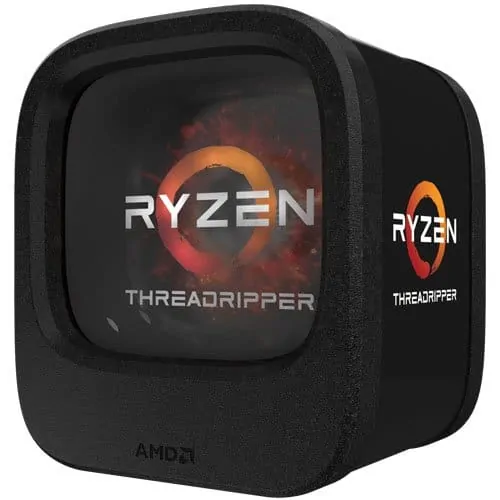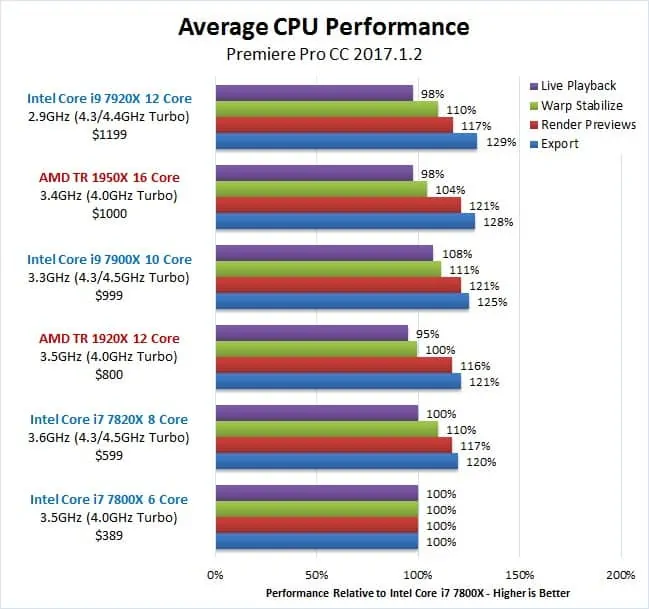Processors always come down in price. And we always get more power as well. That’s just the way it’s always been — with tech too in general. Innovator Gordon Moore knew that, after research, the number of transistors on an integrated circuit doubled every year. Moore’s law was born. Even decades after his 1965 revelation, that principle has remained relatively true, even in this era of VR, holograms, and self-driving cars.
But.
These last few years have seen things go… off the rails.
In a good way.
Intel and AMD are engaged in the Core Wars. For video editors like me, this is the best thing ever.
Just check out this chart:

We can thank AMD for this latest volley. Thanks to the unveiling in 2017 of the Ryzen Threadripper series, CEO Lisa Su and her team laid down the gauntlet. Specifically, with the AMD Ryzen 1950X chip 16 cores and 32 threads. Prices have since dropped, of course, and you can get a veritable steal on this blazing fast multi-core CPU. [Note: the 1950X is going for crazy low prices on Amazon]

Intel didn’t stand still. It i9 range countered as expected, bring even more power and, again, lower prices — at least when you consider price/performance ration.
For someone like me, who lives in the Adobe Creative Cloud, using Illustrator, Lightroom, Audition, and, on a daily basis Premiere Pro this is the stuff of dreams.
Video editors know that encoding and exporting work is important and time consuming, and that faster chips (and memory) help a lot. But, it’s especially important to have high spec CPU and GPU when working (trudging) across the timeline. There we want smooth playback of our video footage, and when we start layering on effects (FilmConvert, Warp Stabilizer, de-flicker, de-noise, Twixtor for slowmo, Lumetri, etc.) we cross our fingers that the timeline doesn’t bog down. Of course it does. It’s natural to expect less performance as you add more layers. There’s somewhat helpful ways around this. You can generate proxy files of your original files which are lower resolution equivalents that scrub faster (when you export Premiere automatically re-attaches the originals). And we can adjust settings, like playing back the timeline at less than full resolution, though we, obviously, would prefer not to do that.
Walter Murch and the Rule of Six for film editing
Since we’re on the topic, one can only turn to the master himself, Walter Murch.
Rule of Six for Film Editing:
1. Emotion
2. Story
3. Rhythm
4. Eye Trace
5. Two Dimensional Place of Screen
6. Three Dimensional Space
Oh, and don’t forget to kill your darlings!
Source: Video & Filmmaker Magazine
So far a guy like me, sitting on the sidelines with a lowly i7 6700k CPU these Core Wars are tantalizing. The only question is when to jump in and benefit from a massive leap in video editing performance.
There are some considerations on timing for potential upgraders like me.
For one, 2nd generation Threadripper chips were unveiled last week. And — surprise — they’e bonkers good. Bonkers performance. Bonkers price. Even when compared to the already legendary original 1950X and family.
For its part Intel is taking the wraps off its 2018 edition of the i9. It too is spectacular, if not more expensive. It would seem Su is not going to compete primarily on price. You’ll pay more for Inten processors. At least for now.
Finally, any decision to upgrade a computer build should consider the GPU. Nvidia is rumored to be taking the wraps off the 2080 at Gamescon next week — the followup to its flagship 1080 TI graphics card.
Put all that together, and, for me at least, the wait continues. Waiting for benchmarks and reviews to come in and possible further price drops. Word too is that memory supply is easing, which should mean eventual drops on memory — I’m especially keen on uber fast M.2 SSDs for caching, project files and media (temporary while editing, before moving off to RAIDs).
Based on my research and as a guy who regards Premiere Pro performance as the ultimate goal I’ll likely still go Intel, despite all the enticing bang-for-the-buck proposition offered up by scrappy AMD.
This chart says it all:

It seems based on what others are saying is that Threadripper and its extra cores don’t really give much benefit to operations in Premiere, especially timeline performance (most reviews focus mostly on exporting times, which is important but not as critical as playback performance on the timeline). In fact, it seems that this particular software does better with a more powerful single core CPU. After a certain number of cores, there’s no appreciable advantage. Again, based on what I’ve found Googling around.

Intel’s i9 appears to offer better timeline performance. Given how critical that is to me — and probably fair to say to any video editor — I’m leaning towards paying a little more for something like a 7920X or 7940X from the i9 series (2017).
Meantime I continue to wait. Prices are dropping. Power is increasing. Dramatically on both fronts. But when to jump in? The research continues…
Since you’re at the end of this article about Intel and AMD and video editing and all that what to do now? Why, watch one of our latest Stark Insider videos! Edited on an i7 6700K Premiere build.
David Lynch. L.A. Festival of Disruption. Lynch out:
Disclosure: my wife works at Adobe.

